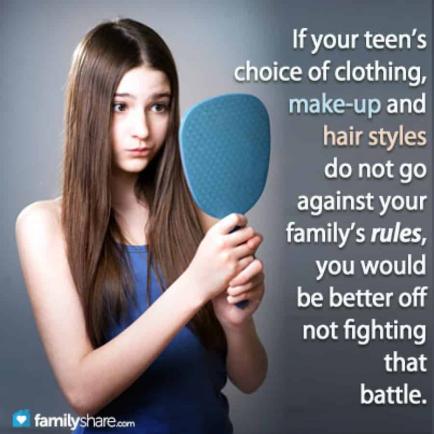
There comes a point in a teen's life where their focus is fixed upon their peers. Having peer acceptance is more important than anything else to a teenager and is no more evident than in appearance and grooming. Teens have their own style, and this style often does not coincide with what Mom or Dad wear, buy or may find in proper taste. Parents often worry when their teen's appearance changes drastically that they are "falling in with a bad crowd"� or that their behavior will change based on their clothing. This usually is not the case. Your teen is simply expressing their individuality by what they are wearing.
Some teens select their outfits simply for the shock value. A case in point is when a teen girl applies a sun bleaching product to her hair, ignoring the caution for brunettes, resulting in a distinct orange color. When her mother lets the incident go without mention, she works for hours trying to find the most drastic hairstyle she could find in order to get a reaction. She exited the bathroom several times, and with each exit, she asked her mother's opinion. Mother gave an opinion like, "If you are happy with the way that your hair looks, that is what matters."� This reaction was not one the rebellious teen wanted. When she finally found the style that Mother said, "Are you leaving the house like that?!?"� the hairstyle stuck for the rest of her teen years (and into her early twenties).
If your teen's choice of clothing, make-up and hair styles do not go against your family's rules, you would be better off not fighting that battle. You can set up guidelines about having a more traditional outfit for dress for formal occasions, but you are wise to leave appearance choices to fall within certain guidelines. Some of the guidelines you may consider are:
1. Personal cleanliness and hygiene
You can insist that your teen keep their body and hair clean. Some (especially those with certain developmental disorders, such as an Autism Spectrum Disorder) may fight it. Teens with Asperger's Syndrome, for example, do not see the need for a regular shower and may resist the use of anti-perspirant or deodorant.
2. Clothing should not be obscene
If your teen has clothing that contains language or graphic images, she should not wear these because of the added problems that these outfits bring (breaking dress code at school, disrupting others, etc.)
3. Clothing may not be too revealing or sexually explicit
Teens may not realize that much of the clothing they see is designed to draw attention to the body. When a teen dresses in a suggestive fashion, it is opening the door for sexual attention, harassment or sexual assault.
4. Teens should dress within a budget
Even when teens have their own spending money, they should limit a percentage of that money to go to their appearance. Using all of their money on clothes can create a real problem later on.
5. Dress must be appropriate for the occasion
It is important to teach (and enforce) a proper dress code. Teens should not wear the same thing to Aunt Ruth's birthday party as they would choose for a dance.

